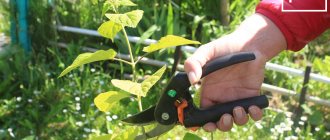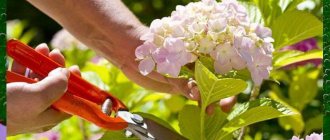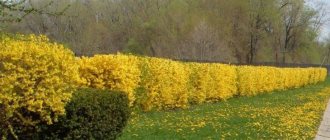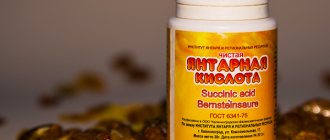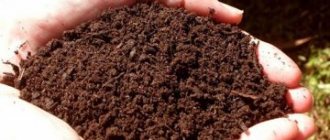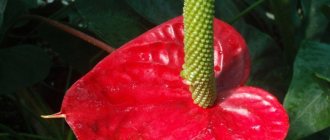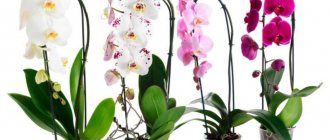Rules for fertilizing hydrangea in the spring
When fertilizing hydrangea, the same rules apply as when fertilizing other garden plants.
- The first feeding after the snow melts is given when the temperature reaches above zero. Only when the soil warms up to +4 +6 degrees are the roots able to absorb nutrients from the environment.
- Watering the plant with a nutrient solution at the root is carried out only on moist soil (the bush is watered abundantly the day before feeding with ordinary water). Roots saturated with moisture will better absorb nutrition and will not get burned.
- The application of solid fractions of fertilizers to the soil surface should be accompanied by shallow loosening, 4-5 cm, and subsequent watering with clean water.
- The solution for foliar feeding (spraying on the leaf) is prepared 2 times weaker than the liquid for watering hydrangeas at the root.
- Bushes should be sprayed in cloudy weather or in the evening, so as not to cause burns on the foliage due to droplets of moisture.
- Nutrient solutions for fertilizing plants should be prepared by accurately measuring the doses of fertilizer. With a high concentration of the active substance, there is a high risk of burning the roots or foliage of the plant.
The specificity of hydrangea cultivation is that it prefers acidic soils for growth. Fertilizers that reduce acidity are not used for it: ash, manure.
Ready-made formulations for feeding hydrangeas
There are many manufacturers that produce special fertilizers for hydrangeas. We studied the compositions of popular fertilizers and noticed that the nutrient content of the preparations is different. Here is the table.
So, for example, in one fertilizer the nitrogen concentration is 2.2%, and in another - 20%. This means that the first is designed for frequent use, and the second has a prolonged effect. Therefore, be sure to read the instructions and remember the main rule of feeding hydrangeas: it is better to underfeed than to overfeed. Both scenarios cause damage, but it is possible to compensate for the shortage of substances, but reducing the excess is much more difficult.
Read about how to independently identify the lack of nutrients and replenish them correctly at the very end of this article.
When to apply fertilizers, timing
In spring, hydrangea wakes up when the snow melts - in April. This is a favorable moment to apply the first fertilizing. It is aimed at supporting the active growth of bush shoots and contains the most nitrogen.
2 weeks after the first feeding, the hydrangea is watered with wood tissue-strengthening compounds. If necessary, acidify the soil.
The next spring feeding is aimed at accelerating the growth of young shoots of the plant. It is held in late May - early June.
The approximate scheme for fertilizing all types of hydrangeas looks like this:
- April 10-18 – application of nitrogen fertilizers to accelerate the growth of foliage and shoots;
- throughout May, hydrangea is sprayed with preparations containing manganese to strengthen and flexibility the shoots;
- at the end of May - beginning of June, they give complex feeding, containing all the basic elements, to improve growth and increase the number of young shoots.
Transplanting hydrangea after winter to another place
Caring for hydrangea in the spring also includes replanting it to another place if necessary. But before doing this, you should prepare the bush in advance.
How to feed hydrangea in spring for lush flowering in the garden
All procedures must be started in advance, namely a year in advance. In order for the plant to undergo replanting painlessly, after flowering it is necessary to remove all faded inflorescences and tie the shoots in a bunch. After this, at a distance of 50-70 cm from the base of the bush, forge a circular ditch 30 cm deep. Place humus tightly in it and water it abundantly. This will allow less trauma to the roots when replanting.
Attention! In spring, the shrub should be dug up with a large ball of earth and moved to a new location.
You can replant hydrangeas when the threat of return frosts has completely disappeared. In the central regions this should be done at the end of April, and in the northern regions - in May. When replanting, you can also divide the bush. To do this, you need to cut the mother plant with a shovel or a sharp knife into 2-3 sections.
Each part should have well-developed root shoots and 2-3 shoots
Step-by-step landing:
- Prepare a hole 2 times larger than the earthen ball.
- Place a layer of broken bricks on the bottom.
- Cover the drainage with a layer of soil.
- Separately prepare a nutritious soil mixture of turf, leaf soil, peat and humus in a ratio of 2:1:1:1.
- Place the seedling in the center so that the root collar is 2 cm below the soil level.
- Fill the resulting voids with soil.
- Compact the surface at the base of the bush.
- Water the plant generously.
The next day, the planting field must be mulched with rotted sawdust or bark.
Important! The hydrangea bush needs to be replanted and divided every 10 years to preserve the decorative appearance of the bush.
Is it possible to replant hydrangea in June?
During this period, it is not recommended to disturb the hydrangea bush, since the plant is already forming buds. The procedure can lead not only to a lack of flowering, but also to the death of the bush.
Replanting in June is necessary only in emergency cases when it is necessary to save the plant.
The bush is gaining more and more popularity
Hydrangea is an unpretentious perennial that has recently gained wide popularity. This shrub easily fits into any landscape design, as a tapeworm and an element of group compositions. At the same time, the plant does not require complex care and therefore even a novice gardener can cope with its cultivation. And the variety of species and varieties makes it possible to create bright floral accents in your garden plot that will delight you with their appearance every season.
How to feed hydrangea in spring for active growth
Fertilizers used for hydrangea are divided into three groups:
- organic (manure, ash, compost, vermicompost);
- mineral (artificial concentrates of various substances);
- folk remedies (infusions, herbal decoctions).
Each type of fertilizer is good in its own way and has pros and cons. You should not give preference to only one type of fertilizer; they are all effective in combination.
For rapid growth of vegetative mass, hydrangeas require nitrogen in the spring. Its maximum amount is contained in manure and bird droppings. But these compounds reduce the acidity of the soil, which is bad for hydrangea. Therefore, these types of fertilizers are not used as top dressing, giving preference to mineral fertilizers and other types of organic matter.
Mineral fertilizers
The mineral fertilizer containing the maximum amount of nitrogen is urea, another name is urea. It contains 46% nitrogen. Urea dosage for feeding hydrangea: 25 g, which is equal to 1 level tablespoon per 10 liters or 1 square meter. m of soil area.
In second place in terms of N content is ammonium nitrate, containing 33% of this substance. Fertilizers take 30 g per 10 liters of water.
Ammonium sulfate not only contains 21% nitrogen, but also has an acidifying effect on the soil, which is what hydrangeas like. It is applied in the form of a solution by watering at the root or by scattering the powder directly on the ground, then loosening and watering. Dosage 35-40 g per 1 square. m.
The chemical industry also produces ready-made complex mineral compositions for feeding hydrangeas for gardeners. They already contain the basic substances needed by the plant in an easily digestible form and the required dosage.
The most popular brands of hydrangea fertilizers among gardeners are:
- Buoy fertilizers (containing nitrogen, phosphorus, potassium and microelements) ensure rapid growth and gorgeous flowering;
- Biomaster offers complex organic-mineral fertilizer (NPK and humates);
- Forte - to increase the formation of inflorescences;
- Fertika - a complex composition for fertilizing plants in late May - early June;
- Agricola promises to enhance the color of flower petals and increase the size of inflorescences.
Along with regular fertilizers, gardeners can purchase special long-acting formulations. Granules or sticks consisting of nutrients are immersed in the soil in the area of the plant's root system. Gradually, under the influence of moisture, the granules dissolve, feeding the hydrangea throughout the season. Such compositions are applied once, in the spring.
Organic fertilizers
Humus or mature compost can be used as the first nitrogen fertilizer for hydrangeas. It is prepared from tops, weeds, vegetable peelings, placing the raw materials in a dense pile and adding the Baikal preparation to speed up the rotting process. After 2-3 years, the plant material turns into a homogeneous crumbly mass.
Humus for feeding hydrangea requires 5-10 kg per bush, depending on the size of the plant. Fertilizer is scattered over the surface of the earth, loosening the soil shallowly, within a radius of 20-30 cm from the hydrangea trunk. To increase the acidity of the soil, peat is added to the humus, up to 100% of the volume of humus.
Biohumus (vermicompost), a waste product of dung worms, is used in the same way. Vermikopost contains humic acids, potassium, phosphorus and other microelements that nourish the plant, strengthen its immunity, and heal the soil.
The liquid form of this fertilizer is an extract and is more quickly absorbed by hydrangea roots. For feeding, 1 part of the fertilizer is dissolved in 8-10 parts of cold water and kept for 24 hours in a warm place. The finished solution is poured under the bush, 8-15 liters each, depending on the size and age of the plant.
Some gardeners use mullein solution for the first feeding of hydrangea, then watering the soil with a solution of citric acid (10 g per 10 l) or vinegar (half a glass per bucket of water) to create the desired acidity.
Mullein is diluted with water in a ratio of 1 to 10 and poured under the root, in an amount of 5-10 liters per plant.
Favorite organic hydrangea fertilizers - video
Folk remedies
“Bread fertilizer” can be used as a nutrient solution for hydrangea. To make it, pour about 1 kg of crackers or stale bread into an 8-10 liter container and fill the product with warm water. The mass ferments in a warm place for about 3 days, then the hydrangea is watered with the liquid. Fertilizer helps increase the content of beneficial microorganisms in the soil.
“Yeast infusion” has similar properties . For 10 liters of warm water take 1.5 tbsp. spoons of dry baker's yeast and 100 g of sugar. The solution is prepared for about a day in a warm place. Before use, it is diluted twice with clean water and poured under the root of the bush.
It is useful for hydrangea to water at the root with a solution based on whey or yogurt. 1 cup of the product is poured into a bucket with 5 liters of water and poured under the bush. Fertilizer acidifies and heals the soil. Spraying hydrangea with the same solution during the budding phase promotes lush flowering of the plant.
In May, when active growth of young hydrangea shoots is observed, the plant is sprayed with a solution of potassium permanganate. The drug improves the elasticity of wood tissue. The solution for treating hydrangea is prepared in pink color.
Pinching, pinching and spring pruning
Spring care for hydrangea in the garden also involves pruning. This procedure is carried out in different ways, depending on the type of crop and its characteristics. Therefore, it is worth familiarizing yourself with what the difference is and how to carry it out correctly in one case or another.
How to prune hydrangea correctly in spring and whether it should be pruned
It is necessary to prune hydrangea only from the second year after planting.
Main types of spring pruning:
- Stepsonning. This method involves removing excess lateral shoots on the shoots, which allows you to increase the size of the inflorescences and achieve lush flowering. The effect is achieved due to the redistribution of nutrients and forces of the plant to the formation of new buds.
- Pinching. In order for the hydrangea to become lush and have a well-groomed appearance, it is necessary in the spring to slightly trim the tops of the shoots by 2-3 cm. This will limit their further growth in length and stimulate the formation of lateral shoots. Pinching should be done in May, when the plant has fully recovered after winter. Pinching allows you to limit the random growth of shoots in different directions.
- Thinning crown pruning. Over time, the perennial grows thickening shoots, which impair the access of air and light inside the bush. Therefore, it is necessary to periodically clean the crown. This procedure can be carried out in spring and autumn.
- Anti-aging pruning. The plant becomes obsolete with age and in order to restore its potential, it is necessary to promptly remove shoots older than 2 years. To rejuvenate the bush, you need to leave no more than 6-9 young branches, and cut the rest at the base. This procedure must be carried out once every 4 years.
Important! In addition to the main types of pruning, it is necessary to use sanitary cleaning, which involves removing broken, dry and damaged shoots.
Pruning large-leaved, serrated and prickly hydrangeas
These types of crops differ in that they bloom on last year's shoots. Therefore, only wilted inflorescences can be cut off on these branches without touching the apical buds.
The optimal period for the procedure is early spring, when the plant is just beginning its growing season. At this time, you need to cut off all frozen and dried shoots.
More drastic pruning should not be used for large-leaved, thorny and serrated hydrangeas, as this may delay flowering until the next season.
Pruning tree and paniculate hydrangeas
These types of perennial bloom on the shoots of the current year. Therefore, they tolerate spring pruning more easily. This procedure needs to be done in March, when the severe frosts have already subsided and the shelter can be removed. You should not delay pruning, as this may delay the onset of flowering.
Pruning should be carried out taking into account the types of crops
- The branches of tree hydrangea can be significantly shortened, leaving only 2-3 buds, and in adult bushes even one is enough. If this is not done, then every year the inflorescences will become smaller and the bushes will thicken.
- Shoots of paniculate hydrangea can be cut only to 1/3 of the entire length. In addition, you need to do a sanitary cleaning of the crown.
How to feed hydrangea in spring for lush flowering in the garden
At the very beginning of summer, hydrangea needs not only nitrogen, but also phosphorus and potassium. Complex mineral fertilizers are suitable for this type of hydrangea, in dosage according to the instructions.
You can use a yeast infusion or an infusion of green herbs, which is prepared as follows: a barrel is filled in half with chopped juicy weeds from the garden (dandelion, wheatgrass without roots, nettles, gooseberry, loach) and filled with water. The mixture should ferment at a temperature of +22 degrees (if the weather is cool, the barrel is placed in a greenhouse) for about a week. The mass is stirred periodically. To reduce the strong stench from fermented grass, pour 1 glass of Baikal solution into the barrel. The finished infusion is diluted with clean water in the ratio: 1 part fertilizer to 10 parts water, and the bush is watered.
To increase the acidity of the soil, which may decrease due to the use of organic fertilizers, hydrangea can be treated with Ferrovit. 1.5 g of powder is dissolved in 1 liter of water and sprayed on the foliage of the bush:
- to prevent the appearance of chlorosis 2 times per summer;
- for the treatment of a disease - every week.
Organic fertilizers
Many gardeners use manure and bird droppings to enrich the soil.
Mullein is poured with water (1:5), infused for a week in a closed container, stirring occasionally.
Before watering, the slurry is diluted with water in a ratio of 1:10.
Chicken droppings (half a liter jar) are poured into 7 liters of water, left for a week, diluted with water 1:15-1:20.
Organic matter is rich in nitrogen, so you should feed the bushes with it only until mid-June, otherwise they will “get fat”, growing shoots with leaves to the detriment of setting buds
How to fertilize paniculate hydrangea in spring
The very first spring fertilizing of the paniculate variety of hydrangea is no different from fertilizing other types of plants. The shrub is fed with nitrogen fertilizers, which stimulate the regrowth of greenery. Use:
- an aqueous solution of cow, horse or goat manure;
- a solution of urea (30 g per 10 liters of water) and potassium sulfate (20 g per bucket of water);
- prolonged complex mineral fertilizer, granules are embedded in the soil.
When watering with nutrient solutions, each bush consumes from 2 to 6 liters of liquid, depending on the size of the plant.
The second feeding is given to the plant at the beginning of summer, when the hydrangea is preparing to lay buds. During this phase, the plant needs all the basic elements: potassium, phosphorus and nitrogen. Apply a complete complex fertilizer for hydrangeas or water the bush with herbal or grain fertilizer, and after a couple of days add a solution of superphosphate and potassium sulfate, 40 g and 30 g per 10 liters of water, respectively.
Types of hydrangeas
More than 80 species of hydrangea are actively used as ornamental plants, of which about 5 thousand varieties have been bred. They differ strikingly in external characteristics. Depending on the variety, it can be a vine, a tree-like shrub, or a herbaceous plant. This leads to a significant difference in care, specifics of maintenance and breeding. The most common types of hydrangeas:
- Tree-like . It grows wild in North America. This is a large plant, the height of which reaches 3 meters. The inflorescences are usually spherical, white or cream-colored. Flowering lasts from June to September;
- Large leaf . The homeland of this variety is Japan and China. It is actively used for landscaping gardens and plots. It is most often used in landscape design; because of its voluminous flowers, it is often called large-flowered. Some varieties are capable of growing up to 4 meters in height, collected in corymbose inflorescences that differ in the shape and color of the petals;
- Paniculata . In its natural environment it can be found in Japan, China and the eastern regions of Russia. Depending on the variety, it is a shrub or tree up to 10 m high. Valued for its dense and very decorative crown of leaves. The flowers are large, the petals are first painted white, and then gradually turn pink.
In addition, oakleaf, petiolate and serrate hydrangeas are used in landscape design for landscaping areas. These are more whimsical plant varieties, so they are less popular.
How to feed hydrangea to change color
Large-leaved hydrangea has an attractive feature from a decorative point of view - the ability to change the color of flower petals, depending on the acidity of the soil. A gardener, by adding certain compounds to the soil, can achieve the appearance of white, pink or blue inflorescences on the bush.
The color of the petals is determined by special substances found in the cell sap of the plant, these are anthocyanates. Depending on the acidity of the soil, these substances change color:
- if hydrangea grows in soil with a neutral reaction, the flower petals will be white;
- an acidic environment will give flowers blue or blue shades;
- In alkaline soil, hydrangea blooms with pink flowers.
In addition to the acidity of the soil, aluminum affects the brightness of the color, enhancing the brightness of the blue color.
To get hydrangea with blue inflorescences on the site, it is necessary to increase the acidity of the soil to a level of 5.5 units and below from April. For this:
- the soil around the plants is mulched with pine needles or acidic peat;
- water the hydrangea with an aqueous solution of ammonium chloride;
- give a solution of aluminum sulfate 15 g per 1 liter of water;
- add ammonium nitrate or urea solution;
- water the plant with a solution of citric acid - 2 tbsp. spoons of powder per bucket of water, spending 1 bucket per bush.
It is necessary to add acidifying solutions to the soil before the end of hydrangea flowering.
Superphosphate and manure solution cannot be used for feeding.
Garden and flower shops sell special fertilizers containing aluminum alum and other elements that increase the acidity of the soil.
Important! To accurately determine the pH level of the soil, you can purchase litmus paper at a garden store.
To obtain blooms in pink-red tones, the acidity of the soil is reduced. To do this, water the hydrangea with an infusion of manure and add a small amount of lime or wood ash. The pH level is checked using litmus paper, bringing it to 6.5-7 units. It is not recommended to exceed this level, as there is a high risk of hydrangea contracting chlorosis.
Fertilizers for acidifying the soil and changing the color of hydrangeas
The color of hydrangeas can be changed by changing the acidity of the soil. The principle is this: the more acidic the soil (5-5.5 pH), the more purple or blue the buds will be. Conversely, the lower the acidity (6-6.2 pH), the more crimson or pink the flowers will be.
To deoxidize the soil, dolomite flour, wood ash, and fluff lime are used.
Important! You can turn blue hydrangeas into pink ones, but the reverse is not so easy. Even with strong acidity of the soil, enough mobile aluminum is needed to change color.
You can additionally add a solution of potassium alum:
- 30-40 g of product;
- 10 liters of water;
- For 1 bush 2-3 liters of solution.
You can also add aluminum sulfate to the soil (up to 500 g per 1 square meter).
Watch the video! Hydrangea - blue or pink? How to change the color of a hydrangea
You can also use special ready-made fertilizers to change the color of hydrangeas:
- Bona Forte in liquid form.
- Bona Forte powder;
Advice! White hydrangeas do not change color.
Gardening tips
Hydrangea paniculata Vanilla Fraze
Experienced gardeners recommend feeding hydrangeas for the first time after spring pruning.
It is convenient to feed large bushes by pouring a nutrient solution into holes made in the soil along the perimeter of the crown. Holes in the ground are made with a sharp stake to a depth of 15-25 cm, 4-6 pieces for each plant. Fertilizer is poured directly into the holes, sprinkling soil on top of the holes. This method of fertilizing allows the fertilizer to reach the roots more quickly, and the valuable liquid does not spread over the soil.
Hydrangea is a moisture-loving plant that is not only watered 2-3 times a week, but also sprayed in hot weather.
The main reasons why hydrangea does not bloom
Sometimes hydrangeas don't bloom because they don't have enough nutrients. There are a number of reasons. Some of them are worth taking into account, since, for example, if the root system of a flower rots or weakens, the plant does not bloom and cannot be fertilized. Remember that not everything depends on the quantity and quality of fertilizing. Although they often become the reason for the lack of budding. Let's figure it out why this happens.
If in the spring the plant begins to quickly gain green mass, and the flower buds do not turn into buds, then the hydrangea has overwintered in unsuitable conditions. The plant does not tolerate temperature drops to 0° and below. Under such conditions, flower buds freeze and may die. Therefore, in the fall, after the last fertilizing of the season has been applied and the perennial has faded, it is covered with insulating materials. In colder regions, such as the Urals, more drastic measures are required. They try to hide low hydrangeas from the cold at home. Tall ones are grown in greenhouses and greenhouses.
The reason for the lack of flowering of hydrangeas may be improper pruning. This disease occurs more often on newly purchased specimens. Pruning is carried out in the spring, clearing the plant of old and wilted stems. Under no circumstances should you cut off last year's strong shoots. Hydrangea flowers form on them. If you do this, you can see the perennial blooming closer to autumn or the next season. The root system of hydrangeas is very powerful. Its development affects the budding of the plant. If it is weakened or develops in clay soil, then the plant may not bloom, stocking up on strength to overcome unsuitable conditions. Also, budding can be affected by the external environment. For example, hydrangeas do not bloom in extreme heat and in insufficient soil moisture. You should not be overzealous with watering, since the plant also does not tolerate waterlogged soils.
Feeding should be timely and in optimal quantities. They can also greatly affect the development of hydrangea buds. If you apply nitrogen fertilizers in the spring, this will significantly delay the appearance of flowers on the bush. In summer, such fertilizing enlarges the inflorescences, but this has a bad effect on decorativeness, since the stems lie down under the weight of the flowers.
